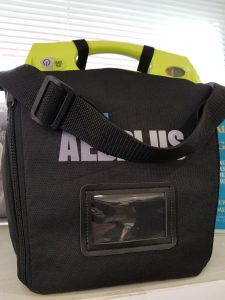Today I made a video that I’m calling “The Tale of Two AED’s”. You can watch the 5 minute video or scroll down to read the tale.
A Tale of Two AED’s.
The past month I’ve been doing a lot of on-site classes. While I’m there I check their AED if they have one. I just make sure the indicator displays that the AED is ready to use and that the pads are not expired. Nothing too invasive, just a quick check.

I was carrying my equipment in to a class and they had their AED on the table. I looked over and the first words I said were “Your AED doesn’t work”. Maybe I could have said that more nicely, but sometimes I don’t have a filter and words just come out. They weren’t shocked, one of them said they knew it wasn’t working. They had new batteries that we put in. And the AED still was not in service.
How did I know it was not ready to use? Take a look at the green handle. On the right side there is an indicator window. What do you see in the window? It should be a green checkmark. Instead it is a red X. That’s how I knew it was not working. I checked the pads and they were expired. Really, really expired.
A few weeks prior to that I was at another location to teach a class. They shared how they bought an AED 2 years prior and had a CPR AED class after they bought it. It was a Philips Heartstart which comes in a red case with a plastic window so you can check the indicator light to make sure it was working. As I was looking at it I didn’t see the indicator light. I waited a bit and then opened the cover to check on it.
So you know how when you buy a product that comes with batteries they have this plastic tab you need to pull to activate the batteries so the product will work? Oh yes…. you guessed it. The plastic tab was sticking out of the AED. It had never been put into service. At the time I didn’t think to take a pic of it, but I will next time I see this. Because it wasn’t the first time I’ve seen this, and it probably won’t be the last. While they should have read the quickstart or manual, I’m surprise the seller or their last instructor did not check this. For 2 years they had an AED that was not in service. You could say that they could have activated and used it if needed, but the unit runs a self-diagnostic when activated and that takes a few minutes. Precious minutes you don’t have when someone is doing CPR.
So why am I writing this Tale of Two AED’s? Because you need to check your AED regularly to make sure it is ready to use. It can take as little as 5 seconds or as long as 30 seconds. AED’s have an indicator that let you know if the AED is ready to use. It can be a green disc or green light or a green checkmark. If you see a yellow or red light, a red disc, a red X, or the green light is flashing like a strobe light – then you need to have your AED checked. With most AED’s you just turn them on and keep pressing down on the power switch and they’ll begin a self-diagnostic. Check your manual with your AED to see how to do this, as each brand is a little bit different. I had someone in a class tell me once they were told to check their AED about once a month. But what if they batteries go or the pads expire a week later? I really think it should be checked several times a week or daily. Do you want to discover your AED is not working when someone is starting chest compressions and you need to use it? Like any other piece of safety equipment, it needs to be checked regularly.
Now a little plug for me – email or call me if you need AED pads, batteries, or supplies! I am working with a new distributor to sell replacement pads and batteries. I could even sell AED’s and might at some point. But I can help you to find the supplies you need quickly and am happy to send a quote or suggest other places to purchase your AED or safety supplies.
Have you checked your AED lately?

